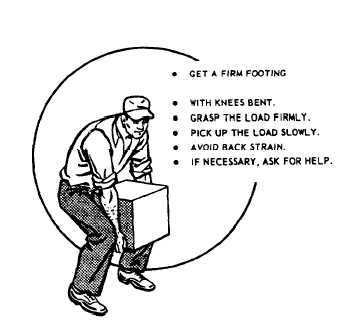| |
Figure 4-9.—Manual lifting.
bulky object close to you. The best way to handle
a compact load is to squat down close to the load
with one foot alongside it and the other foot
behind it. With the feet comfortably spread, you
will have better stability with the rear foot in the
position for the upward thrust of the lift.
3. Pull the load toward you, then lift it
gradually. Avoid quick and jerky motions. Push
upon your legs while keeping your back straight.
A straight back keeps the spine, back muscles, and
other organs of the body in the correct alignment.
Tucking in your chin helps to align the spine. No
matter what size the load, get as close to it as you
can; then get a good grip by using the full palm
and extending your fingers and hands around the
object. Remember that your fingers have very
little power and need the strength of the entire
hand. Keep your arms and elbows tucked into the
side of your body to help keep the body weight
centered. Avoid twisting your body during the lift
or while moving the load; change directions by
moving your feet. Twisting your body during a
lift is one of the most common causes of back
injury.
4. Be sure you have a clear vision over the
load you are carrying.
5. Do NOT change your grip while carrying
the load.
6. Face the spot on which you intend to set
the object down; bend your knees keeping your
back as straight as possible and the weight of the
object close to your body.
7. Always allow enough room for the load to
prevent injury to your toes and fingers.
8. When you are placing a load on a table or
bench, set it down on the edge and push it forward
with your arms and body. If the load is too heavy
or too awkward for you to move alone—GET
HELP! Remember, LIFT WITH YOUR LEGS,
NOT WITH YOUR BACK!
SAFETY
Safety is discussed throughout this manual and
cannot be overemphasized in any phase of the
ship’s store operation. The safety precautions for
the handling of materials are contained in the
Navy Safety Precautions For Forces Afloat,
OPNAVINST 5100.19, chapter 2, section 2.
Material handling involves dangerous opera-
tions that require implementing safe work
practices. The supervisor of the materials-
handling operations is responsible for making sure
all personnel under his or her control are
instructed in and carry out all safety precautions.
The personnel actually involved in the operations
are also responsible for the safety of other
personnel and equipment and should remain alert
at all times to guard against possible injury to
themselves or others, or damage to equipment.
ACCIDENT COST
Accidents involving personnel can have an
adverse effect on productive man-hours and
planned production schedules. Personnel are not
always easily replaced aboard ship and your
division may go short for months before a
replacement is obtained and then the replacement
may not be as skillful as the person lost.
When material is damaged or destroyed by
accidents, time and money is spent to accomplish
necessary repairs or replacement of equipment.
Other consequences include delays in getting work
done, longer working hours, and possible shortage
of critical material.
CAUSES OF ACCIDENTS
Primarily accidents are caused by people.
Equipment is usually involved, but people handle
the equipment. Most accidents are the result of
carelessness, inexperience, and attitude.
4-11
|

